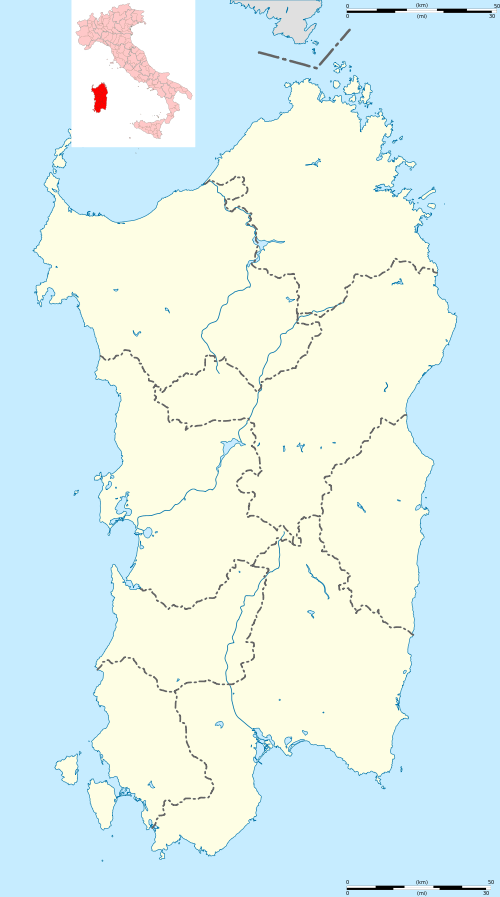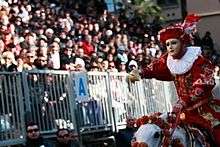Oristano
| Oristano Aristanis | |
|---|---|
| Comune | |
| Comune di Oristano | |
|
Oristano: Statue of Eleanor of Arborea, holding the Carta de Logu in her hand, with the sundial on the wall of the City Hall in the backdrop. | |
 Oristano Location of Oristano in Sardinia | |
| Coordinates: IT 39°54′N 08°35′E / 39.900°N 8.583°E | |
| Country | Italy |
| Region | Sardinia |
| Province / Metropolitan city | Oristano (OR) |
| Frazioni | Donigala, Massama, Marina di Torre Grande, Nuraxinieddu, Silì, Torre Grande |
| Government | |
| • Mayor | Guido Tendas (Centre-left) |
| Area | |
| • Total | 84.63 km2 (32.68 sq mi) |
| Elevation | 10 m (30 ft) |
| Population (31 December 2010) | |
| • Total | 32,156 |
| • Density | 380/km2 (980/sq mi) |
| Demonym(s) |
Oristanesi Aristanesus |
| Time zone | CET (UTC+1) |
| • Summer (DST) | CEST (UTC+2) |
| Postal code | 09170 |
| Dialing code | 0783 |
| Patron saint | St. Archelaus |
| Saint day | February 13 |
| Website | Official website |
Oristano [oriˈstaːno] ![]() listen (Sardinian: Aristanis) is an Italian city and comune, capital of the Province of Oristano in the central-western part of the island of Sardinia. It is located in the northern part of the Campidano plain. Oristano was established as the provincial capital on 16 July 1974. As of December 2010, the city had 32,165 inhabitants.[1]
listen (Sardinian: Aristanis) is an Italian city and comune, capital of the Province of Oristano in the central-western part of the island of Sardinia. It is located in the northern part of the Campidano plain. Oristano was established as the provincial capital on 16 July 1974. As of December 2010, the city had 32,165 inhabitants.[1]
The economy of Oristano is mainly based on services, agriculture, tourism and small industries.
History

Oristano was previously known by the Byzantines as Aristanis (in Byzantine Greek: Αριστάνις), and founded close to the ancient Phoenician settlement of Othoca (now Santa Giusta). It acquired importance in 1070, when, as a result of the frequent Saracen attacks, Archbishop Torcotorio made it the seat of the bishopric, which was previously in the nearby coastal town of Tharros. It also became the capital of the giudicato ("judiciary", equivalent to a Duchy or Kingdom) of Arborea. Consequently, fortifications were designed, but the building thereof went on until judge Mariano II rose to power.
In medieval times Oristano vied for power over the whole island of Sardinia, and therefore waged wars against the other Sardinian kingdoms which culminated in the attempt to conquer the whole island during the reign (1347–75) of Mariano IV and that of his son Hugh III (1376–1383) and his daughter Eleanor (1383–1404). The giudicato of Arborea held out to be the last Sardinian kingdom (Giudicato) to cease to exist in 1420, about 10 years after the battle of Sanluri. It was transformed in Marchesato by the Aragonese and conquered, following a revolt by the last marquess Leonardo Alagon, by the Catalan troops of the Kingdom of Aragon, in 1478 after the battle of Macomer.
Thereafter, Oristano's history was that of the island of Sardinia, characterised by the Aragonese-Spanish (until 1708) and Piedmontese (from 1720) dominations, and then the unification of Italy. In April 1921, David Cova, Emilio Lussu, Camillo Bellieni and other Sardinian veterans of World War I founded in the city the Sardinian Action Party.
Main sights

- The Tower of St. Christophoros, otherwise known as Tower of Mariano II, was built in 1290, is 19 metres (62 ft) tall and the most striking remaining evidence of the old walls built at the time of the Giudicato, as it was one of the main gates thereof.
- Torrione ("Big Tower") of Portixedda.
- St. Mary's Cathedral (1130) was rebuilt during the reign of Mariano II after being destroyed in a siege. Of the original structure of Mariano, only parts of the apse and base of the campanile are left, as well as the Gothic Chapel of the Rimedio, which houses some medieval sculptures. Parts of a more ancient Byzantine edifice can be seen in the court. To the 17th century renovation belongs the Chapel of the Archivietto ("Chapel of the Small Archive"). The current Baroque style is largely from the 19th-century restoration. It has been supposed that the Cathedral was used for the burials of the giudici and their families, but the subsequent dominations have deleted all traces of them. In the interior is a wooden statue of the Annunziata, attributed to Nino Pisano.
- The Church of St. Francis of Assisi was built around 1200 and is currently in neo-classical style. Therewithin is the Christ of Nicodemus, a wooden sculpture believed to be the work of Valencian masters, dating back to the 14th century.
- The Franciscan church of Santa Chiara (consecrated in 1428) is an edifice in French-Gothic style with a single nave and a square apse.
- The Church and cloister of the Carmine is one of the best examples of Baroque-Roccoco architecture in Oristano.
- The Church of Saint Sebastian is the only medieval extramural church, i.e. it is located outside the walls.
- The Church of Saint Dominic (San Domenico) was built in 1634 at the initiative of friar Pietro Flores and financially supported by local nobleman Baldassarre Dedoni. Citizens also made donations in exchange for 2 square metres (22 sq ft) of floor space for a tomb therewithin. The building is a rectangularly-shaped chamber with two chapels formed in its right side wall: one of them is dedicated to Saint Vincent and the other one to the name of Jesus. Most notably, it has a wood retable that served as the main altar and includes several niches dedicated to Saint Dominic and other Saints. Upon the suppression of religious orders in 1832 the Dominicans, who had been in charge until then, bequeathed the church to the archconfraternity of the Saint Name of Jesus. It was thereafter refurbished several times, deconsecrated and currently serves as an Auditorium for congresses and concerts.
- In the village of Massama is the small pre-Romanesque church called Oratory of the Souls, showing influences from the Visigothic art of the 8th century.
Culture
Sa Sartiglia and other events


Sa Sartiglia, otherwise known at its inception as Sartilla, is an equestrian tournament held in Oristano for the past 500 years on Carnival Sunday and Mardi Gras. The tournament on Sunday is organized by the Corporation (Gremio) of farmers, whereas that on Mardi Gras is organised by the Gremio of carpenters. It has arguably an ancient Castillan origin. Researchers M. Falchi and M. Zucca found a manuscript dating the first tournament to 1543, whereas Pau, a late local historian, believed it originated in Oristano before the Spaniards set foot on the island. In fact, in a letter written to an English friar in the 14th century, St. Catherine of Siena stated that the Judge of Arborea could provide two galleys and one thousand horsemen to fight in a crusade for ten years. While being far from conclusive evidence that the tournament had already been, or was about to be held, this letter is certainly a testament to the importance of horse-breeding in Oristano and its surrounding countryside at the time.
The name "Sartiglia" comes from Sortija which, in turn, evolved from the Latin word Sorticola, the diminutive form of Sors which does not only mean fate and fortune, but also "ring".
The ring is a tin star provided with a hole at its centre, hanging from a ribbon strung above horseman's height across the street near the Cathedral, at which masked horsemen aim with their swords on steeds galloping at breath-taking speed, after being announced by trumpets and drums and having gathered pace down a route, covered with sand, snaking across the town centre. The number of stars caught on each day is a sign of the wealth that the harvest and carpentry work will bring to the corporations.
At the end of Sa Sartiglia, elsewhere within the old walls, another sand covered route will be trodden by horses ridden by those same masked horsemen and women showing their stunning prowess, while engaging in all sorts of acrobatics on two and three galloping steeds at a time. This is called La Pariglia, and ends at sunset.

The leader of both trials is called Su Componidori, meaning "the one who marshals". He is chosen by the members of the Corporations, who do not disclose his name until Candlemas, when Su Majorale announces it directly to the appointee and a careful selection of the horses as well as adequate practice can start. He is neither a man, nor a woman but androgynous, much akin to the land and, at the end of the tournament, blesses bystanders and the town with the "little doll of May" (Sa Pippia 'e maiu), a bunch of flowers swaddled in a ribbon, believed to pre-date the tournament itself, followed by the other horsemen at a canter first, and then alone, riding with his back on his galloping steed's, face up gazing at the Heavens.
Transport
Oristano can be reached by train from Sardinia's ports of Olbia and Porto Torres, and the island's main cities Cagliari and Sassari. From Oristano all villages of the province can be reached by buses departing the bus station close to centrally-located Piazza Mannu. Moreover, a private concern provides a twice-daily bus service to and from Cagliari Elmas Airport. The journey takes approximately 2 hours.
Oristano is served by the Fenosu Airport, far 3 km (2 mi) from the city, and by a cargo sea port.
Climate
| Climate data for Oristano, Sardinia | |||||||||||||
|---|---|---|---|---|---|---|---|---|---|---|---|---|---|
| Month | Jan | Feb | Mar | Apr | May | Jun | Jul | Aug | Sep | Oct | Nov | Dec | Year |
| Average high °C (°F) | 13.2 (55.8) |
13.2 (55.8) |
14.7 (58.5) |
16.7 (62.1) |
20.8 (69.4) |
24.5 (76.1) |
27.8 (82) |
28.8 (83.8) |
26.0 (78.8) |
21.9 (71.4) |
17.3 (63.1) |
14.4 (57.9) |
19.9 (67.8) |
| Average low °C (°F) | 7.6 (45.7) |
7.5 (45.5) |
8.6 (47.5) |
10.3 (50.5) |
13.7 (56.7) |
17.3 (63.1) |
20.1 (68.2) |
21.1 (70) |
18.7 (65.7) |
15.3 (59.5) |
11.3 (52.3) |
8.8 (47.8) |
13.4 (56.1) |
| Average rainfall mm (inches) | 50.0 (1.969) |
60.5 (2.382) |
44.4 (1.748) |
51.4 (2.024) |
32.8 (1.291) |
16.7 (0.657) |
4.4 (0.173) |
7.3 (0.287) |
34.2 (1.346) |
69.7 (2.744) |
92.5 (3.642) |
65.0 (2.559) |
528.9 (20.822) |
| Average rainy days (≥ 1 mm) | 8 | 8 | 7 | 8 | 5 | 2 | 1 | 1 | 4 | 8 | 10 | 9 | 71 |
| Source: [2] | |||||||||||||
Twin towns – sister cities
Oristano is twinned with:
-
 Ciutadella de Menorca, Spain, since 1991
Ciutadella de Menorca, Spain, since 1991 -
 Garden City, Kansas, United States
Garden City, Kansas, United States
See also
References
- Bibliography
- Sartiglia, La grande Giostra equestre di Oristano. Sassari: Soter. 1994.
- Oristano, La Sartiglia. Cagliari: L'Unione Sarda. 1992.
- Notes
- ↑ All demographics and other statistics: National Institute of Statistics (Italy) (Istat).
- ↑ Weather Service of the Italian Air Force " Servizio Meteorologico dell' Aeronautica Militare"
External links
![]() Media related to Oristano at Wikimedia Commons
Media related to Oristano at Wikimedia Commons
- (Italian) Oristano official website

